Here are two ads I don’t know exactly how to interpret. They shimmer with ambiguity, and it is difficult to get inside the head of a “typical” reader from the 1890s. What did they mean to the target audience, who are most likely men? Presumably they both employ humor – but what’s the joke exactly?
(Do the intentions of their creators, also likely men, matter as well? I’m inclined to focus more on reception than on intention, and I think the reception will exceed and swerve around the intent, but perhaps you’ll have a better idea.)
The images don’t fit neatly into the binary pair of “Angel in the House” or “Madwoman in the Attic” – they are ambivalent and unclear. They suggest freedom while at the same time limiting it, suggest praise but also the back-handed compliment. We aren’t at a full embrace of bloomers and ballots.
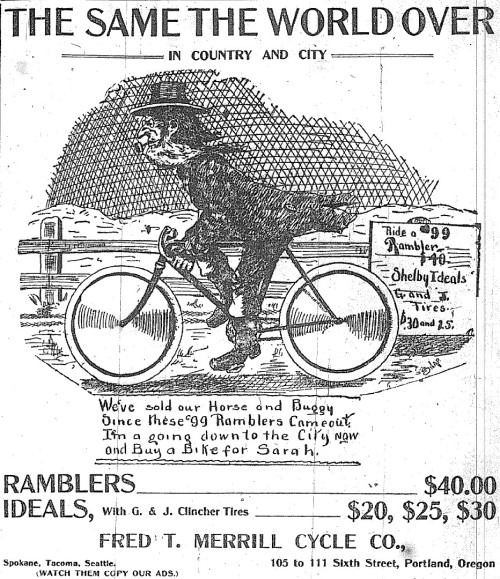
We've sold our horse and buggy...I'm a going down to the City Now and Buy a Bike for Sarah
It’s hard to know whether Sarah is a wife or daughter, and whether the hayseed – and I take him for one – is being made fun of for getting a modern conveyance for his wife – who if she’s younger might use it to leave him! Or is he progressive and modern, a relative good guy? Or perhaps this interpretation just maps modern preoccupations onto a more innocent image. The focus, though, is on male agency, not on Sarah’s. What’s going on here?
Here’s another one.

Battle Ax is a "Scorcher" because it sells so fast...and goes so far
The OED first attests to “battle axe” used for a forceful woman in 1896. This ad is from July 1896! Are we seeing an early use for the word? Is it a joke? Attitudes towards the woman seem ambiguous: She’s young and kinda “hot,” possibly drawn as an object of desire, but she’s also derided as a “scorcher,” someone dangerous. Of course it’s a benign form of scorching: coasting down a hill quickly, not running over people on the sidewalk. So she’s not too dangerous, maybe just alluring with a whiff of brimstone.
But the metaphors get more twisty: The ad equates chewing tobacco with a scorcher – this woman is scorching – so there’s a second-order implied act of eating the woman? Is this hostility towards the liberated woman? The take on sexuality here is not clear, but it’s difficult to imagine there’s not something going on. It’s ambivalent with a lot of push and pull.
Not a matter of culture or sexual politics, but do note the bike is a fixie, whose pedals rotate rapidly when coasting, which is why she has to elevate her feet over the front tire. On descents, pedals were known to have severed arteries in lower legs and caused death! And of course she’s not wearing a helmet.
And is there a secondary audience of selling tobacco to women? I mean, this could operate simultaneously for men as a joke on women, and ironically operate for women as a laudable image.
What do you know about broader cultural signifiers in the late Gilded and early Progressive Eras? If you can unpack these images better, please drop a comment!
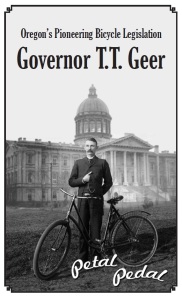


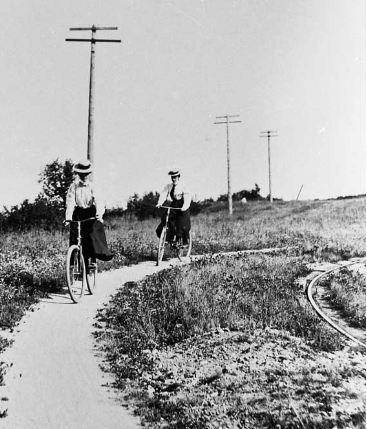
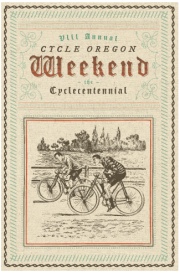
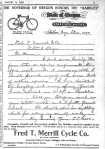
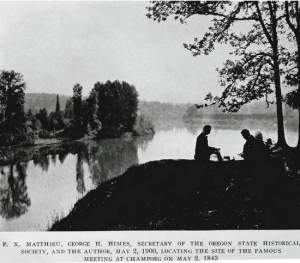
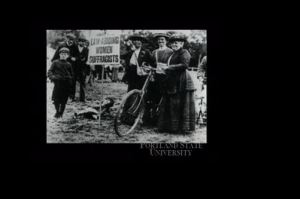
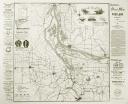

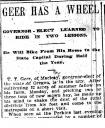 “Geer has a wheel. Governor-elect learned to ride in two lessons. He will bike from his home to the State Capital during half the year.”
“Geer has a wheel. Governor-elect learned to ride in two lessons. He will bike from his home to the State Capital during half the year.”